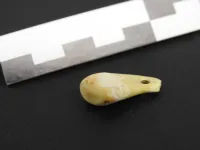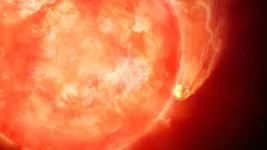As a star runs out of fuel, it will billow out to a million times its original size, engulfing any matter — and planets — in its wake. Scientists have observed hints of stars just before, and shortly after, the act of consuming entire planets, but they have never caught one in the act until now.
In a study that will appear in Nature, scientists at MIT, Harvard University, Caltech, and elsewhere report that they have observed a star swallowing a planet, for the first time.
The planetary demise appears to have taken place in our own galaxy, some 12,000 light-years away, near the eagle-like constellation Aquila. There, astronomers spotted an outburst from a star that became more than 100 times brighter over just 10 days, before quickly fading away. Curiously, this white-hot flash was followed by a colder, longer-lasting signal. This combination, the scientists deduced, could only have been produced by one event: a star engulfing a nearby planet.
“We were seeing the end-stage of the swallowing,” says lead author Kishalay De, a postdoc in MIT’s Kavli Institute for Astrophysics and Space Research.
What of the planet that perished? The scientists estimate that it was likely a hot, Jupiter-sized world that spiraled close, then was pulled into the dying star’s atmosphere, and, finally, into its core.
A similar fate will befall the Earth, though not for another 5 billion years, when the sun is expected to burn out, and burn up the solar system’s inner planets.
“We are seeing the future of the Earth,” De says. “If some other civilization was observing us from 10,000 light-years away while the sun was engulfing the Earth, they would see the sun suddenly brighten as it ejects some material, then form dust around it, before settling back to what it was.”
The study’s MIT co-authors include Deepto Chakrabarty, Anna-Christina Eilers, Erin Kara, Robert Simcoe, Richard Teague, and Andrew Vanderburg, along with colleagues from Caltech, the Harvard and Smithsonian Center for Astrophysics, and multiple other institutions.
Hot and cold
The team discovered the outburst in May 2020. But it took another year for the astronomers to piece together an explanation for what the outburst could be.
The initial signal showed up in a search of data taken by the Zwicky Transient Facility (ZTF), run at Caltech’s Palomar Observatory in California. The ZTF is a survey that scans the sky for stars that rapidly change in brightness, the pattern of which could be signatures of supernovae, gamma-ray bursts, and other stellar phenomena.
De was looking through ZTF data for signs of eruptions in stellar binaries — systems in which two stars orbit each other, with one pulling mass from the other every so often and brightening briefly as a result.
“One night, I noticed a star that brightened by a factor of 100 over the course of a week, out of nowhere,” De recalls. “It was unlike any stellar outburst I had seen in my life.”
Hoping to nail down the source with more data, De looked to observations of the same star taken by the Keck Observatory in Hawaii. The Keck telescopes take spectroscopic measurements of starlight, which scientists can use to discern a star’s chemical composition.
But what De found further befuddled him. While most binaries give off stellar material such as hydrogen and helium as one star erodes the other, the new source gave off neither. Instead, what De saw were signs of “peculiar molecules” that can only exist at very cold temperatures.
“These molecules are only seen in stars that are very cold,” De says. “And when a star brightens, it usually becomes hotter. So, low temperatures and brightening stars do not go together.”
“A happy coincidence”
It was then clear that the signal was not of a stellar binary. De decided to wait for more answers to emerge. About a year after his initial discovery, he and his colleagues analyzed observations of the same star, this time taken with an infrared camera at the Palomar Observatory. Within the infrared band, astronomers can see signals of colder material, in contrast to the white-hot, optical emissions that arise from binaries and other extreme stellar events.
“That infrared data made me fall off my chair,” De says. “The source was insanely bright in the near-infrared.”
It seemed that, after its initial hot flash, the star continued to throw out colder energy over the next year. That frigid material was likely gas from the star that shot into space and condensed into dust, cold enough to be detected at infrared wavelengths. This data suggested that the star could be merging with another star rather than brightening as a result of a supernovae explosion.
But when the team further analyzed the data and paired it with measurements taken by NASA’s infrared space telescope, NEOWISE, they came to a much more exciting realization. From the compiled data, they estimated the total amount of energy released by the star since its initial outburst, and found it to be surprisingly small — about 1/1,000 the magnitude of any stellar merger observed in the past.
“That means that whatever merged with the star has to be 1,000 times smaller than any other star we’ve seen,” De says. “And it’s a happy coincidence that the mass of Jupiter is about 1/1,000 the mass of the sun. That’s when we realized: This was a planet, crashing into its star.”
With the pieces in place, the scientists were finally able to explain the initial outburst. The bright, hot flash was likely the final moments of a Jupiter-sized planet being pulled into a dying star’s ballooning atmosphere. As the planet fell into the star’s core, the outer layers of the star blasted away, settling out as cold dust over the next year.
“For decades, we’ve been able to see the before and after,” De says. “Before, when the planets are still orbiting very close to their star, and after, when a planet has already been engulfed, and the star is giant. What we were missing was catching the star in the act, where you have a planet undergoing this fate in real-time. That’s what makes this discovery really exciting.”
This research was supported, in part, by NASA, the U.S. National Science Foundation, and the Heising-Simons Foundation.
###
Written by Jennifer Chu, MIT News Office
END




